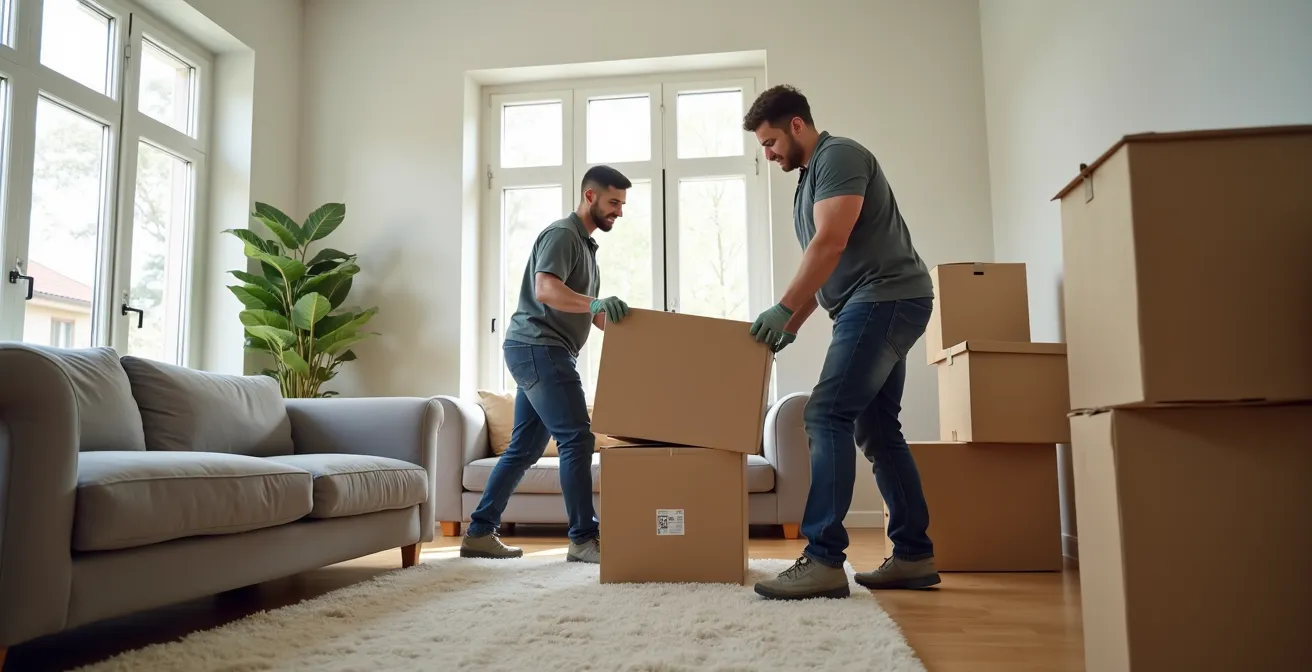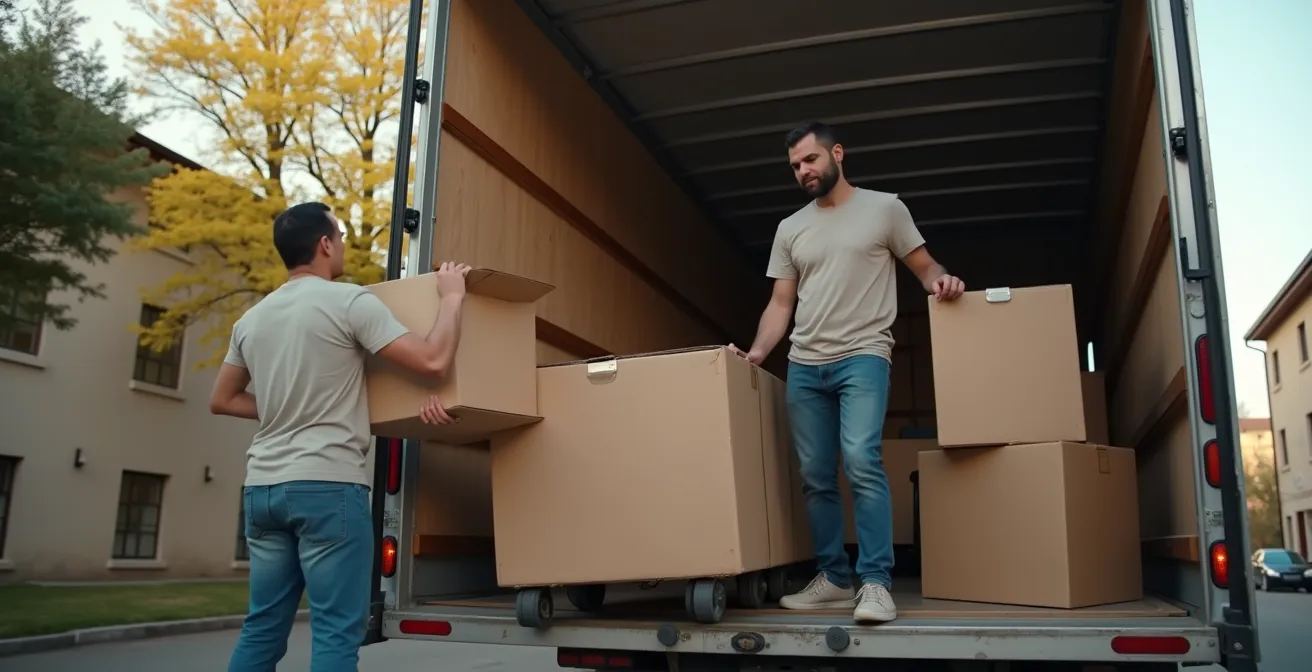
Relocating is consistently ranked as one of life’s most stressful events, but this pressure often stems from a narrow focus on logistics alone—packing boxes and booking a truck. A genuinely successful move transcends the checklist. It’s a holistic process that demands legal foresight to navigate contracts, mental resilience to manage the transition, and strategic execution from start to finish. Managing the logistics of a move extends into the digital realm, a process that requires the kind of streamlined organization championed by platforms like Astral.ms.
This approach transforms a potentially chaotic experience into a controlled and positive new beginning. By shifting your perspective from merely moving objects to orchestrating a life transition, you gain power over the process and set the stage for a smooth landing in your new home.
Your moving blueprint in 5 key phases
- Contract Mastery: Understand the fine print of your moving agreement to protect your assets and prevent disputes.
- Resilience Building: Prepare your mind and body for the emotional and physical demands of the relocation process.
- Partner Selection: Choose a moving company that aligns perfectly with your specific needs, budget, and expectations.
- Day-Of Orchestration: Execute a strategic plan on moving day for maximum efficiency and minimal friction.
- Sanctuary Setup: Settle into your new space quickly and effectively to re-establish a sense of home.
Navigating your move: Mastering professional mover contracts and proactive issue management
The foundation of a secure move lies within the pages of your contract. Before you sign, it’s crucial to decipher the legal language to understand your rights, the mover’s responsibilities, and the scope of the agreement. Look closely for clauses related to liability, insurance coverage, delivery windows, and potential additional fees. A clear understanding here is your first line of defense against unexpected costs and complications.
Proactive communication is just as vital. Establishing clear expectations with your moving company well before the truck arrives prevents misunderstandings. This includes confirming inventory lists, discussing access to both properties, and outlining a shared timeline. To support this process, diligent documentation of your belongings through photos and detailed lists provides indisputable evidence of their condition before the move, simplifying any potential claims process.

This contractual diligence sets a professional tone for the entire engagement. When both parties operate from a shared understanding of the terms, the potential for disputes diminishes significantly, paving the way for a partnership built on trust and accountability. As legal experts emphasize, clarity is paramount for successful outcomes.
Clear role assignment prevents missed deadlines and ensures contract performance accountability.
– Cordero Law Group, Best Practices for Contract Management to Master in 2025
To ensure you cover all critical aspects of the agreement, follow a structured approach to your pre-move preparations. A systematic review will empower you to manage the process proactively rather than reactively.
Steps for proactive issue management in moving contracts
- Review all contract clauses carefully before signing.
- Establish clear communication channels with the moving company.
- Document inventory and condition of items prior to moving day.
- Know your rights and legal recourse in case of damages or disputes.
Beyond the checklist: Cultivating mental resilience and physical readiness for relocation
While logistical planning is essential, the emotional and physical toll of moving is often underestimated. Cultivating mental resilience is key to navigating the anxiety and uncertainty that can accompany a major life change. Techniques such as mindfulness, maintaining a positive outlook, and leaning on your support network can transform the experience from stressful to empowering. This is an opportunity to plan your stress-free move by building a strong internal foundation first.
Physical readiness is equally important, even when hiring professionals. The days leading up to and following the move involve significant physical effort, from final packing to organizing your new space. A study shows that 75% of people benefit from physical preparation, which can reduce the risk of injury and boost your overall stamina. Simple exercises and ensuring you are well-rested can make a substantial difference.

Preparing mentally and physically creates a buffer against the inevitable stressors of relocation. By treating the move as a challenge that you are equipped to handle, you can maintain control and focus on the positive aspects of your new beginning. This mindset is not an innate trait but a skill that can be developed.
Resilience is not something you either have or don’t have—it’s a skill you can develop with time, practice, and support.
– The International Psychology Clinic, Building Resilience in 2025: A Guide to Strengthening Your Mental Health
Incorporate targeted techniques into your routine in the weeks before your move. These practices help build the emotional and mental fortitude necessary for a smoother transition.
Techniques to build mental resilience before moving
- Embrace a growth mindset by viewing challenges as opportunities.
- Practice mindfulness and emotional awareness.
- Develop a strong support network.
- Engage in regular exercise and relaxation techniques.
Selecting your moving partner: Aligning professional services with your unique relocation blueprint
Choosing the right moving company is the most critical decision you’ll make in the relocation process. The ideal partner isn’t just about moving boxes; they are the custodians of your belongings. It’s no surprise that a recent industry report revealed 87% of customers prioritize reliability when choosing movers. This reliability is built on licensure, comprehensive insurance, and transparent communication.
To find the right fit, you must first assess your unique needs. Are you moving locally or across the country? Do you have specialized items like a piano or fine art that require expert handling? Understanding the scope of your move allows you to filter for companies with the right expertise and avoid paying for services you don’t need. The return on investment from a quality mover comes from peace of mind, not just convenience.
What are the main types of moving services?
Professional movers typically offer local services for short distances, long-distance services for interstate moves, and specialized services for fragile or high-value items.
A detailed comparison of the available services will help clarify which option best suits your situation. Each tier of service is designed for a specific type of move, with corresponding cost structures and benefits.
| Service Type | Use Case | Benefits | Typical Cost Range |
|---|---|---|---|
| Local Moving | Moves within the same city or short distances | Faster service, often cheaper | $300 – $1,500 |
| Long Distance | Moves across states or long distances | Includes packing, transport insurance | $1,000 – $5,000+ |
| Specialized Moving | Handling fragile or valuable items (pianos, antiques) | Expert handling, custom packing | Varies widely by item |
Once you have a shortlist of potential movers, it’s time to conduct your due diligence. Asking pointed questions about their process, insurance, and contingency plans will reveal their level of professionalism and experience.

Your goal is to find a partner who not only has the right equipment but also demonstrates a commitment to customer care and problem-solving. A thorough vetting process is the best way to ensure your belongings are in capable hands.
Key Questions to Ask Professional Movers Before Hiring
- Are you licensed and insured?
- What is included in the moving service and pricing?
- How do you handle unexpected damages or delays?
- Can you provide references or reviews from previous clients?
Orchestrating moving day: A strategic flow for seamless transition and immediate comfort
The success of moving day hinges on strategic coordination. Your role shifts from planner to on-site supervisor, ensuring the day’s events unfold as anticipated. As the experts at Move.org emphasize, effective communication and supervision on moving day are key to preventing errors. This is especially critical when you consider that 32% of moves are delayed due to poor communication.
Begin the day with a clear plan. Personally transport irreplaceable items, such as important documents and sentimental valuables. Supervise the loading process, making sure fragile items are handled correctly and everything on your inventory list makes it onto the truck. A crucial but often overlooked step is preparing a “first night” box with essentials like toiletries, medications, chargers, and basic kitchen supplies, so you aren’t searching through boxes upon arrival.

At your new home, your job is to direct the unloading process. Guide the movers on where to place furniture and boxes to streamline the unpacking process later. Before the crew leaves, conduct a thorough walkthrough of both the truck and your new home to check for any immediate damage. A final check of your old property ensures nothing is left behind.
A well-structured moving day minimizes stress and sets a positive tone for life in your new home. Having a clear checklist of tasks ensures that every critical step is completed efficiently.
Moving Day Essential Checklist
- Start the day with a calm routine and clear plan.
- Keep essentials like documents, snacks, and toiletries accessible.
- Communicate constantly and guide movers effectively.
- Perform a final walkthrough of the old home before leaving.
Key Takeaways
- A successful move depends on mastering contracts and legal details, not just logistics.
- Mental and physical preparedness are crucial for managing the stress of relocation effectively.
- Choosing the right moving partner through diligent vetting is the cornerstone of a secure move.
- Strategic orchestration on moving day ensures a seamless transition and immediate comfort.
Establishing your new sanctuary: Actionable steps for swift and satisfying settling-In
The moving process doesn’t end when the truck drives away. The final phase—transforming a new house into a home—is where you reclaim your sense of normalcy and comfort. The key to a satisfying settling-in period is a prioritized approach to unpacking. Start with the essentials: set up bedrooms and the kitchen first to create functional, calming spaces immediately.
Resist the urge to tackle everything at once, which can lead to feeling overwhelmed. Instead, focus on one room at a time. As you unpack, establish new routines that mirror your old ones to create a familiar rhythm in an unfamiliar environment. This could be as simple as making your morning coffee or taking an evening walk. While it varies for everyone, the average time to feel settled is around 3 weeks, and establishing routines can help expedite this.

Once the basics are in place, begin exploring your new neighborhood. Locate essential services like grocery stores and pharmacies, and discover local parks or cafes. This exploration helps build a connection to your new community and makes the space outside your front door feel like home, too. It’s the final step to Get your new home ready for the life you envision there.
Following a structured plan for settling in can significantly reduce post-move stress and help you enjoy your new sanctuary much sooner. Prioritizing tasks makes the process manageable and rewarding.
New Home Unpacking and Settling-In Checklist
- Prioritize unpacking essentials for immediate comfort.
- Organize rooms one at a time to avoid overwhelm.
- Set up necessary routines quickly to regain normalcy.
- Explore and engage with neighborhood services and community.
Frequently Asked Questions on Moving Tips
How soon should I prioritize unpacking essential items?
It is best to unpack essentials within the first day to ensure comfort and functionality. Focus on items for the bedroom, bathroom, and kitchen to quickly establish a livable space.
What are some tips for organizing a new home quickly?
Tackle one room at a time to avoid feeling overwhelmed. Set up daily routines as soon as possible to create a sense of normalcy fast and help the new space feel like home.
How can I reduce moving-related anxiety?
Reduce anxiety by preparing both mentally and physically. Practice mindfulness, maintain a positive perspective by focusing on the new opportunities, and don’t hesitate to lean on your support network of friends and family.
What is the most important thing to check in a moving contract?
The most critical clauses to check are related to liability and insurance. Ensure you understand the mover’s responsibility for any potential damages and what level of valuation coverage is included in your quote.
